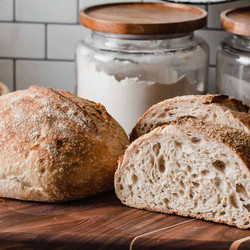12 hours before you plan to mix the dough, add the ingredients to make ½ cup (100 g) of active sourdough starter to a clean jar. Stir until combined, loosely cover the jar and let the starter rise at room temperature. (The ingredients will create a total of 115 g active starter but, because some of it will stick to the sides of the jar during the transfer, we are making a little more than needed.) The sourdough starter is ready to use when it has doubled in size and there are plenty of bubbles on the surface and sides of the jar.
Autolyse (1 hour): In a mixing bowl, add 330 grams of water and 100 grams active sourdough starter, stir to combine. Add 50 grams whole wheat flour and 450 grams bread flour and use your hands to combine the ingredients until there are no dry bits and the dough looks like a shaggy mass. Cover the bowl and let the dough rest on the counter for 1 hour.
Add salt (1 hour): Add 10 grams of salt to 30 grams of water in a small bowl and stir to dissolve. Add the salt water to the dough and use your hands to work it in until well combined. Cover the bowl and let rest on the counter for 1 hour.
Bulk Fermentation (3-5.5 hours): Perform 3 sets of stretch and folds, 30 minutes apart. To perform a set, while the dough is still in the bowl, pick up one side with a wet hand. Pull it up and over itself. Turn the bowl and repeat this action on 4 sides of the dough until the bowl has come full circle. (See notes)Cover the dough and allow to ferment at room temperature for 1-3 more hours according to the following temperatures. 68°F (20°C) 2-3 hours70°F (21°C) 2-2.5 hours72°F (22°C) 1.5-2 hours75°F (24°C) 1-1.5 hoursThe dough is ready for shaping when it has risen about 20-30% and has bubbles around the edges of the bowl.
Shaping: Turn the dough out onto a lightly floured surface and use a bench scraper to form it into a loose ball. Cover and let rest for 20 minutes. Lightly flour the surface of the dough ball and use a bench scraper to turn it over. Final shape the dough by pulling the side nearest yourself up and towards the center of the dough. Repeat on all fours sides of the dough. Flip the dough over, seam-side down, and use your hands to twist the dough on the counter. Cup the dough with your hands and gently pull it towards yourself to create a tight skin on the outside. Flour the outside of the dough ball. Flour the inside of a banneton and place the dough ball into the banneton, seam-side up. Cover the bowl with a large plastic bag and let rest on the counter for 30 minutes.
Second Rise (8-36 hours): Place the covered dough in fridge to cold ferment 8-36 hours.
Score and Bake: Remove the dough from the fridge and let sit at room temperature for 30 minutes. Preheat the oven, with the dutch oven inside, to 500°F (260°C) for 30 minutes.Turn the dough out onto a piece of parchment paper and score the top with a razor. Remove the dutch oven and place on stove-top. Use the parchment paper as a sling and lift the dough up and into the dutch oven. Cover, turn oven down to 450°F (232°C) and bake for 20 minutes. Remove the cover and bake an additional 25-30 minutes or until the crust is at the desired color.
Let the bread cool on a cooling rack for 2 hours before cutting.
